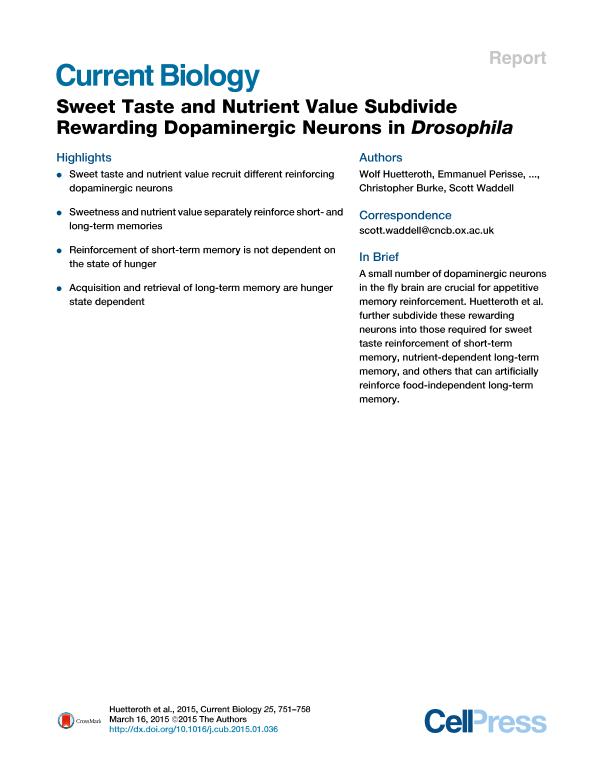Mostrar el registro sencillo del ítem
dc.contributor.author
Huetteroth, Wolf
dc.contributor.author
Perisse, Emmanuel
dc.contributor.author
Lin, Suewei
dc.contributor.author
Klappenbach, Martín

dc.contributor.author
Burke, Christopher
dc.contributor.author
Waddell, Scott
dc.date.available
2018-03-08T20:28:19Z
dc.date.issued
2015-03
dc.identifier.citation
Huetteroth, Wolf; Perisse, Emmanuel; Lin, Suewei; Klappenbach, Martín; Burke, Christopher; et al.; Sweet taste and nutrient value subdivide rewarding dopaminergic neurons in drosophila; Cell Press; Current Biology; 25; 6; 3-2015; 751-758
dc.identifier.issn
0960-9822
dc.identifier.uri
http://hdl.handle.net/11336/38320
dc.description.abstract
Dopaminergic neurons provide reward learning signals in mammals and insects [1-4]. Recent work in Drosophila has demonstrated that water-reinforcing dopaminergic neurons are different to those for nutritious sugars [5]. Here, we tested whether the sweet taste and nutrient properties of sugar reinforcement further subdivide the fly reward system. We found that dopaminergic neurons expressing the OAMB octopamine receptor [6] specifically convey the short-term reinforcing effects of sweet taste [4]. These dopaminergic neurons project to the β′2 and γ4 regions of the mushroom body lobes. In contrast, nutrient-dependent long-term memory requires different dopaminergic neurons that project to the γ5b regions, and it can be artificially reinforced by those projecting to the β lobe and adjacent α1 region. Surprisingly, whereas artificial implantation and expression of short-term memory occur in satiated flies, formation and expression of artificial long-term memory require flies to be hungry. These studies suggest that short-term and long-term sugar memories have different physiological constraints. They also demonstrate further functional heterogeneity within the rewarding dopaminergic neuron population.
dc.format
application/pdf
dc.language.iso
eng
dc.publisher
Cell Press

dc.rights
info:eu-repo/semantics/openAccess
dc.rights.uri
https://creativecommons.org/licenses/by-nc-nd/2.5/ar/
dc.subject
Dopamine
dc.subject
Reward
dc.subject
Drosophila
dc.subject.classification
Otras Ciencias Biológicas

dc.subject.classification
Ciencias Biológicas

dc.subject.classification
CIENCIAS NATURALES Y EXACTAS

dc.title
Sweet taste and nutrient value subdivide rewarding dopaminergic neurons in drosophila
dc.type
info:eu-repo/semantics/article
dc.type
info:ar-repo/semantics/artículo
dc.type
info:eu-repo/semantics/publishedVersion
dc.date.updated
2018-03-02T14:18:25Z
dc.journal.volume
25
dc.journal.number
6
dc.journal.pagination
751-758
dc.journal.pais
Estados Unidos

dc.description.fil
Fil: Huetteroth, Wolf. University of Oxford; Reino Unido. University of Konstanz; Alemania
dc.description.fil
Fil: Perisse, Emmanuel. University of Oxford; Reino Unido
dc.description.fil
Fil: Lin, Suewei. University of Oxford; Reino Unido
dc.description.fil
Fil: Klappenbach, Martín. University of Oxford; Reino Unido. Consejo Nacional de Investigaciones Científicas y Técnicas. Oficina de Coordinación Administrativa Ciudad Universitaria. Instituto de Fisiología, Biología Molecular y Neurociencias. Universidad de Buenos Aires. Facultad de Ciencias Exactas y Naturales. Instituto de Fisiología, Biología Molecular y Neurociencias; Argentina
dc.description.fil
Fil: Burke, Christopher. University of Oxford; Reino Unido
dc.description.fil
Fil: Waddell, Scott. University of Oxford; Reino Unido
dc.journal.title
Current Biology

dc.relation.alternativeid
info:eu-repo/semantics/altIdentifier/doi/http://dx.doi.org/10.1016/j.cub.2015.01.036
dc.relation.alternativeid
info:eu-repo/semantics/altIdentifier/url/https://www.sciencedirect.com/science/article/pii/S0960982215000688
Archivos asociados
